Posts Tagged ‘Emily of Deep Valley’
November 18, 2013 @ 7:57 pm | Filed under:
Books 
 I’m not in a book club at present, but I’ve been entertaining myself with thoughts of what books I would suggest to my book club if I belonged to one. This is because I finished Elizabeth Gilbert’s sweeping, sad, thoughtful The Signature of All Things, and naturally I’m yearning for a nice long discussion of it, preferably involving baked goods. (I’m also wanting to start a moss garden, which in San Diego would be no mean feat.)
I’m not in a book club at present, but I’ve been entertaining myself with thoughts of what books I would suggest to my book club if I belonged to one. This is because I finished Elizabeth Gilbert’s sweeping, sad, thoughtful The Signature of All Things, and naturally I’m yearning for a nice long discussion of it, preferably involving baked goods. (I’m also wanting to start a moss garden, which in San Diego would be no mean feat.)
Other books I would throw into the ring:
1) The Diamond Age, Or: A Young Lady’s Illustrated Primer by Neal Stephenson. I read it a year or two before the advent of the iPad, and when that magical device appeared, all I could think of was the Primer. I enjoyed the book’s exploration of a ‘best’ education—what that might look like, what its aims might be, and the unpredictability of outcomes. And the mind-stretching nanotechnology permeating and altering society: this is a richly layered and sometimes difficult book, with much that made me uncomfortable (something I appreciate in a book), but also a compelling page-turner of a narrative. It’s one of those books I think about in the context of daily life quite often (and not just in connection to the iPad). It would be fun to dig into with a really lively, argumentative group of readers.
2) The Children’s Book by A. S. Byatt. I’ll be drummed out of my own imaginary book club if I keep suggesting these mammoth tomes, but there it is. I’ve read The Children’s Book twice (three times? I’m losing track) in four or five years (also losing track; can’t be bothered to check my log now) and like The Diamond Age (and, I suspect, The Signature of All Things), it’s a book I find myself pondering in many a stray moment. A curling fern frond, a strand of seaweed, a beautifully glazed pot, the Nesbit books on my shelf, a reference to William Morris, a pre-Raphaelite painting, a sinister undercurrent in a fairy tale—any number of things send me straight back into the pulsing green world of this Fabian family and their troubled, talented, struggling circle of artist-friends. Downton Abbey was full of reminders (Lavinia’s clothes, Sybil’s causes, Branson’s political activism, the devastation and radical shifting of relationships and ways of life during and after WWI). No work of fiction in recent years has sent me on more rabbit trails, nor hounded my thoughts so relentlessly.
3) Feed by M. T. Anderson. It’s been several years; I’m due for a reread. Every year this book feels more prescient. We may not have the Feed implanted in our brains quite yet, but we’re closer than we were the first time I read it. Won’t it be fun to fumble for words about how alarming we found the notion of a society so dependent on an advertising-driven stream of information piped directly into their minds that people can barely form a coherent thought anymore, much less an original one? And then we can all post photos of our desserts to Instagram.
4) Hmm, we’ll need something by Muriel Spark. A Far Cry from Kensington, I think, but perhaps I’m leaning too much on my own favorites. Certainly The Prime of Miss Jean Brodie would provide fodder for hours of discussion. Actually, Miss Brodie would make a tremendous follow-up to Feed and The Diamond Age: all of them exploring ways of educating (even shaping) young minds. Oh, what am I talking about—Signature and The Children’s Book fall right into that category as well. Education isn’t by any means the only theme of these books, but it’s a dominant thread in each, one way or another. You’d almost think this was a pet topic of mine, or something.
5) Well then, let me throw something entirely different into the mix: how about American Terroir: Savoring the Flavors of Our Woods, Waters, and Fields by Rowan Jacobsen. I can brag about how he’s a friend and former classmate of mine, and of course we’ll have to have a tasting party to accompany our discussion of this book, a fascinating exploration of how terrain affects flavor (in many subtle ways), and why certain regions are famous for specific foods. I’ll bring the chocolate, you bring the maple syrup.
6) Now here I go reverting back to favorite books about unconventional upbringings, but when’s the last time you read Midnight Hour Encores? It’s one of my favorite YA novels, right up there with Emily of Deep Valley (though utterly unlike) and…hmm, that’s a different list, my favorite YA. Anyway: Encores features one of my favorite dads in all of literature, and an ending that takes my breath away every time.
7) But it isn’t quite fair of me to stack the deck with books I’ve already read, most of them more than twice. How about something new? I’ve got Donna Tartt’s latest, The Goldfinch, on hold at the library. I’m #70 in the queue, but since this is an imaginary book club, I’ll just imagine myself next in line.
How about you? What’s up next in your book club—real or imagined?
Tags: A.S. Byatt, American Terroir, Bruce Brooks, Elizabeth Gilbert, Emily of Deep Valley, Feed, M.T. Anderson, Midnight Hour Encores, Muriel Spark, Neal Stephenson, Rowan Jacobsen, Signature of All Things, The Children's Book, The Diamond Age, The Prime of Miss Jean Brodie, what I'm reading, what to read in book club, YA
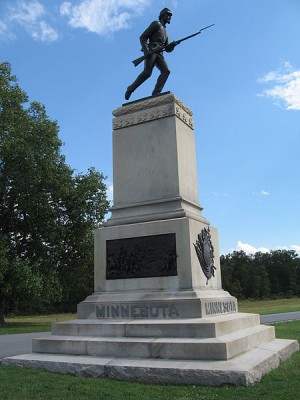 Image source: Wikimedia Commons.
Image source: Wikimedia Commons.
Reading this story, my heart is in my throat.
The Battle of Gettysburg, Day 2, July 2nd, 1863.
“The scene is the center of the American line. Most of the attacks on the flanks have been repulsed by now, or nearly so, and the sun is near to setting. The American lines are now almost set into the famous ‘fish-hook’ formation that one can find on so many maps. But the operative word is ‘almost.’
“In the center, there is a gap…”
The writer is Lt. Col. Robert Bateman, and his recounting of the events in the weeks leading up to Gettysburg has had me enthralled for days. I’ve followed him from Fredericksburg, Virginia—the town, incidentally, where I graduated from college, and where I met Scott—north to Pennsylvania, his posts spanning the months of June and July, 1863, just over 150 years ago. I don’t particularly want to be in Gettysburg right now; my attention ought to be far to the south, in Alabama. But I can’t look away. Lt. Col. Bateman’s account is riveting.
“In the center, there is a gap because one American Corps commander took it upon himself to move well forward earlier in the fight. The rebels are now finishing crushing that Corps. But ever since that audacious Union Corps commander created that gap in the first place, a succession of recently arriving units have been fighting to keep the middle from collapsing. Now, as the sun sets over Seminary Ridge, the game is almost over. But there is a half-mile opening in the remaining American line, and two whole rebel brigades are headed straight to it.”
You’ll have to read the entire post to get the full thrust of what’s on the line in this moment—heck, you ought to read the whole series—but some of you will understand why this next passage made me gasp.
The American Corps commander now in charge of the section of the line closest to the hole, a fellow named Hancock, sees what is about to happen. The rebels are moments away from breaking the center of the Union line. His own Corps line ends several hundred yards to the north. The next American unit to the south is a quarter mile away. Hancock can see the reinforcements he has called for, as can others on the crest of the hill. Those troops are marching at full speed up the road. By later estimates, the relieving troops are a mere five minutes away from the ridgeline. But the Confederates are closer.
I talked about psychology yesterday. I wrote about how sometimes something that can only be described as moral ascendency (or perhaps morale ascendency) can make it possible for a smaller force to defeat a larger force — first emotionally, then physically. Rufus Dawes and his 6th Wisconsin Infantry pulled that off on the First Day, albeit at a horrendous cost. General Hancock understands in an instant the bigger picture. This is not some small slice of the field. He sees that if the rebels make it to the ridge, they might gain the psychological advantage over the whole Army of the Potomac, much of which is still arriving. So the rebels must be stopped. Now. Here.
And now, what I am about to describe to you transcends my own ability to explain. Hell, it is beyond my own understanding, and I have been a soldier for decades.
General Hancock sees a single American regiment available. But, though it is a “regiment,” this is in name only at this point. A “regiment,” at the beginning of the war, would be roughly 1,000 men. Before Hancock stand 262 men in American blue. Coming towards them, little more than 250 yards away now, are two entire brigades of rebels. Most directly, half of that force — probably about some 1,500 men from a rebel brigade — were coming dead at them. Perhaps a thousand more, at least two entire additional regiments, were on-line with that main attack, though probably unseen by Hancock. But what does that matter? The odds were, already, beyond comprehension.
“My God! All these all the men we have here…What regiment is this?” Hancock yelled.
“First Minnesota,” responded the colonel, a fellow named Colvill.
First Minnesota.
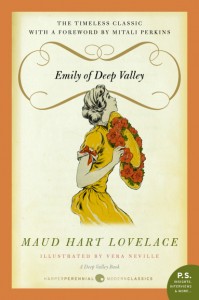 That’s right, Lovelace readers. The very regiment Emily Webster’s grandfather fought in, the one Carney’s Uncle Aaron (her great-uncle, surely) died in—in that charge on the second day of the Battle of Gettysburg.
That’s right, Lovelace readers. The very regiment Emily Webster’s grandfather fought in, the one Carney’s Uncle Aaron (her great-uncle, surely) died in—in that charge on the second day of the Battle of Gettysburg.
“When Colonel Colville told us to charge,” [Grandpa] said, nobody ran out on that field any faster than Aaron Sibley.”
“You ran fast enough to get a bullet through your arm.”
“Only winged, only winged,” he answered impatiently. “It might have been death for any one of us.”
It was for a good many of them, Emily remembered. She had heard her grandfather say many times that only forty-seven had come back out of two hundred and sixty-two who had made the gallant charge.
—from Emily of Deep Valley by Maud Hart Lovelace
“Every single man of the 1st Minnesota,” writes Lt. Col. Bateman,
“placed as it was at the crest of the gentle slope, could see what was going on. All of them were veterans, having fought since the beginning of the war. Each of them understood the exact extent of what they were being asked to do by General Hancock. And, it would appear, that they all understood why.
“On this day, at the closing of the day, there was no illusion that they might win. There was not any thought that they could throw back a force more than seven or eight times their own size. Not a one of them could have entertained the idea that this could end well for them, personally.
“I suspect, though of course nobody can actually ‘know,’ that there was only a silent, and complete, understanding that this thing must be done. So that five minutes might be won for the line and the reinforcements and that their widows and children might grown up in a nation once more united, they would have to do this thing. Then, as men, the 262 men of the 1st Minnesota followed their colonel as he ordered the advance, leading them himself, from the front.
“They charged, with fixed bayonets, to win 300 seconds for the United States. Union and Confederate sources agree on this next point: There was no slacking, no hesitation, no faltering. The 1st Minnesota charged, en masse, at once alone and together. One hundred and fifty years later, those 300 seconds they then won for the United States have proven timeless. Because it worked. They threw a wrench into the rebel attack, stalling it, before the inevitable end.
“And, as Fox’s Compendium pointed out in cold, hard numbers, it only cost 82 percent of the men who stepped forward.”
Grandpa Webster and Aaron Sibley are fictional characters, but they are based on real people, just as Emily and Carney were. In the afterword to HarperPerennial’s 2010 edition of Emily of Deep Valley, Lovelace historian Julie A. Schrader tells us that Grandpa Cyrus Webster represented a man named John Quincy Adams Marsh, the grandfather of Maud’s friend Marguerite Marsh, the “real” Emily. He was not, however, a Civil War veteran. Schrader writes,
“Maud appears to have based Grandpa Webster’s experiences on those of Captain Clark Keysor (Cap’ Klein)…. General James H. Baker, a veteran of the Dakota Conflict and the Civil War, was the basis for the character of Judge Hodges. In 1952 Maud wrote, ‘Old Cap’ Keysor and General Baker used to visit the various grades on Decoration Day to tell us about the Civil War…'”
Emily is, as I’ve often mentioned, not only my favorite Maud Hart Lovelace book, it’s one of my favorite novels period. Grandpa Webster is very real to me. I can’t describe my astonishment to find him there, suddenly, in Lt. Col. Bateman’s account, rushing unhesitatingly toward that gap in the line. 262 men made the charge. 47 survived. One of them was Cap’ Clark Keysor, who visited Maud’s school classrooms and told her stories she never forgot. Nor shall I.
***
For Lt. Col. Bateman’s entire Gettysburg series, click here.
For more background on the real people who inspired Maud Hart Lovelace’s characters, I highly recommend Julie Schrader’s book, Maud Hart Lovelace’s Deep Valley.
Related posts:
Why I love Carney
Why I love Emily
A Reader’s Guide to Betsy-Tacy
Saturday at Midwinter was a happy day for Maud Hart Lovelace fangirls like me…HarperPerennial hosted a booksigning, giving away tote bags and copies of Carney’s House Party and Emily of Deep Valley to a crowd of happy conference-goers. Mitali Perkins and I signed our forewords in the gorgeous reissues, and I loved getting to meet so many fellow Betsy Ray devotees, including several lovely women I know from the Maud-L discussion list.


With Maud-L listren Nancy D. and Kathleen W., a happy meeting!

The lovely Mitali Perkins



Me, HarperPerennial’s Jennifer Hart, and Mitali Perkins

Delightful lunch company. All of us are card-carrying members of the Betsy Tacy Society. (Well, I guess baby Lucy isn’t carrying a card…yet.)
Related posts:
Heaven to Betsy! High-school-and-beyond books being reissued! (Sept 2009)
Betsy and Tacy Go Over the Big Hill
Betsy-Tacy e-books!
The Betsy-Tacy Songbook
Interview with Mitali Perkins, Jennifer Hart, and me about Maud’s books
Photos of my visit to the real Deep Valley, as chronicled by Margaret in Minnesota
Why I love Carney
Why I love Emily
A Reader’s Guide to Betsy-Tacy
 The blog A Library Is the Hospital of the Mind is hosting a Maud Hart Lovelace reading challenge during the month of October. Pick out some Betsy-Tacy or Deep Valley books and skip on over to sign up. Participants will have a chance to win copies of HarperPerennial’s brand-new reissues of Emily of Deep Valley and (in a double volume, two books in one) Carney’s House Party / Winona’s Pony Cart. You know, the book I’ve been squeeing about for months, the one I had the thrill-me-to-my-very-bones honor of writing the foreword for? That one!
The blog A Library Is the Hospital of the Mind is hosting a Maud Hart Lovelace reading challenge during the month of October. Pick out some Betsy-Tacy or Deep Valley books and skip on over to sign up. Participants will have a chance to win copies of HarperPerennial’s brand-new reissues of Emily of Deep Valley and (in a double volume, two books in one) Carney’s House Party / Winona’s Pony Cart. You know, the book I’ve been squeeing about for months, the one I had the thrill-me-to-my-very-bones honor of writing the foreword for? That one!
Not sure where to start?
Here’s a rundown of the Betsy-Tacy books and their Deep Valley companions.
Book 1: Betsy-Tacy. Betsy Ray’s story—which is very, very similar to Maud’s real life story—kicks off on her fifth birthday, the day she gets to know her lifelong best friend, Tacy Kelly. From that day forth they are inseparable, which is why the neighbors always call them Betsy-Tacy. That’s the first book: very young girls having sweet and funny adventures in small-town Minnesota at the turn of the last century. It’s a lovely read-aloud for small girls, though I always give other mothers a heads-up about the death of Tacy’s baby sister, which happens quite early in the book and is very sensitively and quietly handled.
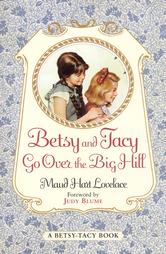 In Book 2, Betsy-Tacy and Tib, Betsy and Tacy roam farther from home, all the way to the grand chocolate-colored house a few blocks away—where they meet Tib, whose spritelike looks belie her blunt and practical nature. This is the year the girls learn to fly, explore the Mirror Palace, and concoct Everything Pudding. It’s the year Tacy has diphtheria and Tib and Betsy cut off their hair in solidarity. It’s a year full of exactly the right sort of mischief.
In Book 2, Betsy-Tacy and Tib, Betsy and Tacy roam farther from home, all the way to the grand chocolate-colored house a few blocks away—where they meet Tib, whose spritelike looks belie her blunt and practical nature. This is the year the girls learn to fly, explore the Mirror Palace, and concoct Everything Pudding. It’s the year Tacy has diphtheria and Tib and Betsy cut off their hair in solidarity. It’s a year full of exactly the right sort of mischief.
In Book 3, Betsy and Tacy Go Over the Big Hill, the girls are the extremely sophisticated age of ten. Venturing to the other side of the Big Hill is a big deal—here, I’ve already written a big long post about it.
Book 4: Betsy and Tacy Go Downtown. Now the girls are twelve—old enough to go all over town by themselves. Christmas shopping, Mr. Poppy’s Opera House, a friendly rivalry with spunky Winona Root, the newspaperman’s daughter. That’s the year the first horseless carriage comes to town, as well as a troupe of traveling actors. Betsy, Tacy, and Tib get involved with the play and there is a delicious bit of family drama as well.
Those are the four “young” Betsy-Tacy books (collected now in a beautiful Treasury edition with a foreword by Judy Blume). Chronologically, Winona’s Pony Cart fits in that group; the central event is Winona Root’s 8th birthday. She gets herself into a bit of a scrape having to do with her party, and she’s not the only member of her family who makes a misstep, and what I love about this book—probably the most overlooked of Maud’s Deep Valley stories—is the earnestness with which Winona and her parents strive to recover from their individual errors of judgment. I was so happy to get to unpack this book more thoroughly in the foreword to the reissue. Winona is a girl to remember.
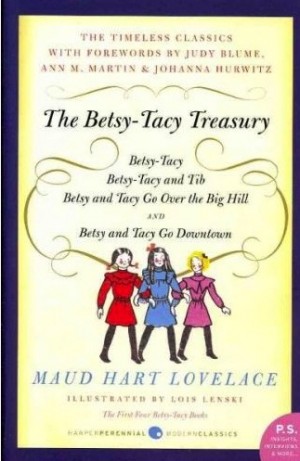
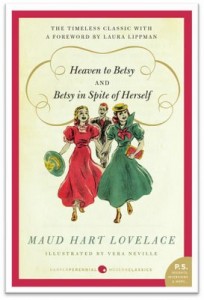
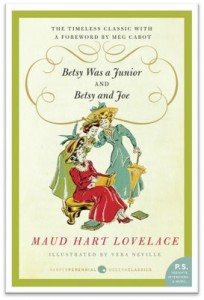

Now come Betsy’s high-school-and-beyond books.
Freshman year: Heaven to Betsy, which I wrote about here. New house, new school, new friends; Sunday night lunches, dances, skating parties. Joe Willard at Butternut Center. A crush on Tony; a Betsy struggling with moods and competing wishes. A Betsy who writes but doesn’t quite know what to do with her writing, doesn’t know how to reconcile the need to slip away and work with the desire to be in the thick of the merry-making crowd.
Sophomore year: Betsy in Spite of Herself. It’s a makeover story! One of my favorite plot devices. Betsy is determined to reinvent herself into a creature more glamorous, more poised, more devastating to boys. Only trouble is, her own irrepressible self keeps bubbling up and taking over. This is the year of the fascinating Christmas visit to Tib’s German relatives in Milwaukee, the year of Phil Brandish and his red auto.
Junior year: Betsy Was a Junior. Sorority fever. The joys of being part of a clique—and the crash that comes when you realize you’ve forgotten about the feelings of people outside your in-crowd. I think Betsy does some of her best growing up in this book, especially after that incident with her little sister Margaret and the stove.
Senior year: Betsy and Joe. My favorite, because, well, Betsy and Joe.
After high school, there’s Betsy and the Great World—she got off to a rough start in college and her folks wisely surmise that someone who wants to be a writer might benefit from travel. So off she goes to Europe by steamer. Things are rocky with Joe, and that undercurrent of tension gives her some perspective as she explores Munich, Venice, London, and more. A beautiful book. And oh that perfect telegram!
And then, ever so satisfyingly, Betsy’s Wedding. I adore this book. Rings so true. The fun of finding and fitting out your first apartment, the comic misadventures of learning to run your own home. And (especially this) there’s Betsy’s challenge to make room for her writing, and to give Joe room for his. As a writer married to a writer, this book hits me where I live.
Two more Deep Valley gems
Chronologically, Carney’s House Party fits in between Betsy and Joe and Betsy and the Great World. Carney is one of Betsy’s best high-school friends, a year ahead of Betsy, Tacy, and Tib in school. Her famous house party takes place the summer after her freshman year at Vassar. Her somewhat snobby roommate, Isobel, comes to Deep Valley for an extended visit with Carney’s family. Rounding out the party are Carney’s best friend, Bonnie Andrews, home from Paris, and in a surprise appearance, good old Betsy Ray. It’s hard for me to contain my remarks about this book to one little paragraph—though I managed it before when I wrote “Carney’s House Party is one of my favorite of Maud Hart Lovelace’s books—I love how honestly Carney grapples with the complicated process of sorting out her college self from her hometown self.” Yeah, that’s it. I got to indulge in a meatier exploration of what makes this book tick in the foreword I wrote for the reissue.
 And then there’s Emily of Deep Valley. I’ve written about her at length. Short version: Emily’s a quieter sort than Betsy and Carney; she lives on the edge of the Slough with her elderly grandfather, the only family she has left. All her friends are heading off to college but Emily won’t leave her grandpa alone—a difficult decision, and a right one. Loneliness and depression set in, but she (famously) musters her wits to combat them. There is much to love about this book, but if I had to pick a favorite part, it would be the relationships that develop between Emily and the Little Syrian boys, and what comes of their connection. HarperPerennial’s lovely reissue of Emily of Deep Valley, with a moving foreword by author Mitali Perkins, plus historical material by Maud Hart Lovelace experts Julie Schrader and Amy Dolnick, as well as a bio of illustrator Vera Neville, will hit the shelves on October 12th. If you haven’t read this rather incredible book it would be a perfect choice for the MLH reading challenge.
And then there’s Emily of Deep Valley. I’ve written about her at length. Short version: Emily’s a quieter sort than Betsy and Carney; she lives on the edge of the Slough with her elderly grandfather, the only family she has left. All her friends are heading off to college but Emily won’t leave her grandpa alone—a difficult decision, and a right one. Loneliness and depression set in, but she (famously) musters her wits to combat them. There is much to love about this book, but if I had to pick a favorite part, it would be the relationships that develop between Emily and the Little Syrian boys, and what comes of their connection. HarperPerennial’s lovely reissue of Emily of Deep Valley, with a moving foreword by author Mitali Perkins, plus historical material by Maud Hart Lovelace experts Julie Schrader and Amy Dolnick, as well as a bio of illustrator Vera Neville, will hit the shelves on October 12th. If you haven’t read this rather incredible book it would be a perfect choice for the MLH reading challenge.
Of course you know I’m hoping you’ll read Carney and Winona too so we can gab about them!

Related posts:
Emily of Deep Valley
Heaven to Betsy! High-school-and-beyond books being reissued! (Sept 2009)
Betsy and Tacy Go Over the Big Hill
Betsy-Tacy booksigning at ALA Midwinter
Betsy-Tacy e-books!
The Betsy-Tacy Songbook
Interview with Mitali Perkins, Jennifer Hart, and me about Maud’s books
Photos of my visit to the real Deep Valley, as chronicled by Margaret in Minnesota
Why I love Carney
A Reader’s Guide to Betsy-Tacy
This afternoon, Jennifer Hart (aka @bookclubgirl) posted a picture of the Carney’s House Party/Winona’s Pony Cart and Emily of Deep Valley reissues with those gorgeous Vera Neville covers. The official pub date is less than a month away. Squee!
I got a sneak peek at Mitali Perkins‘s foreword for Emily of Deep Valley, and it is quite moving: an account of her discovery of the Maud Hart Lovelace books—and Emily in particular—as a young newcomer to America, “wandering the stacks of the children’s book section in the Flushing Public Library.”
My own foreword for the Carney/Winona double volume was a joy and an honor to write. But having Carney, Winona, and Emily back in print is the greatest joy of all. If you haven’t yet read the Deep Valley novels—companions to the Betsy-Tacy series—you are in for such a treat!
ETA: Bumping this up from the comments for all to see:
HarperPerennial’s Jennifer Hart writes: “Thank you for posting the link to the photo Melissa! It’s very exciting. I can’t stop looking at the books – there’s your foreword, Mitali’s, wonderful archival photos and writeups from Julie Schrader and Amy Dolnick – plus the never-before-published bio by Theresa Gibson of the elusive Vera Neville (with her photo!)”
Related posts:
Emily of Deep Valley
Heaven to Betsy
Betsy and Tacy Go Over the Big Hill
…over these gorgeous covers for the new reissues of the Maud Hart Lovelace Deep Valley Books!


These lovely reissues of Emily of Deep Valley (with a new foreword by Mitali Perkins) and Carney’s House Party / Winona’s Pony Cart (foreword by yours truly) will arrive in bookstores on October 12th.
I am counting the days!
Posts I’ve written about Maud’s wonderful books, because I love them with a mad passion:
Betsy and Tacy Go Over the Big Hill
Heaven to Betsy
Emily of Deep Valley, my hero
The famous Cat Duet
UPDATED 2012: Thanks to the tireless efforts of HarperPerennial’s Jennifer Hart and the Betsy-Tacy Society, all of Maud Hart Lovelace’s Deep Valley books are now back in print. They’ve been reissued in beautiful editions with vintage illustrations, photographs, and introductions by authors who cherish the Betsy-Tacy books, including Judy Blume, Anna Quindlen, Meg Cabot, Mitali Perkins, Laura Lippman, and yours truly. 🙂 I’ve written about the entire series (with a chronological list) here.
The post below was written in early 2007, when many of Maud’s books were going out of print.
 It’s almost hard for me to believe, now, that I grew up without Betsy Ray and her Deep Valley friends. I never heard of the Betsy-Tacy books until 1994, when I was a young staffer at HarperChildren’s, and the galleys for the reissues—the very editions that are now going out of print—began to float across my desk. You never saw a happier little coffee-fetcher than the girl I was, newly married and soon to be expecting baby Jane, sitting in my cubicle devouring those galleys and getting paid for it. Not paid a whole lot, mind you, but still.
It’s almost hard for me to believe, now, that I grew up without Betsy Ray and her Deep Valley friends. I never heard of the Betsy-Tacy books until 1994, when I was a young staffer at HarperChildren’s, and the galleys for the reissues—the very editions that are now going out of print—began to float across my desk. You never saw a happier little coffee-fetcher than the girl I was, newly married and soon to be expecting baby Jane, sitting in my cubicle devouring those galleys and getting paid for it. Not paid a whole lot, mind you, but still.
Where had Betsy Ray been all my life?
Clearly she was a kindred spirit of the likes of my beloved Anne and Laura. I loved her instantly and passionately, right down to her gap-toothed smile. My own dear mama has the same smile, and I could picture Betsy’s grin exactly. (I would have it too, but for the junior-high braces.)
I had taken that job because I wanted to write, and I hoped working in a publishing house would open some doors for me. (Happily, it did.) In the evenings I would go home to the bitsy three-room Queens apartment in which Scott and I began our married life, and the whole scene was so very Betsy-and-Joe I could hardly contain myself. Betsy’s bird print above her writing desk (Uncle Keith’s trunk) reminded me of the picture I’d hung on the wall beside our computer: a sepia-toned print of a stone doorway between a courtyard and a garden, taken at a monastery we’d passed through briefly on our honeymoon. That doorway spoke to me of all the possibilities that lay on the other side. Step through, it beckoned, and see what surprises await you down these paths.
Betsy would have understood just how I felt.
Even little tiny Betsy, the five-year-old or the ten-year-old: she knew all about the fun of discovering what lay over the Big Hill or alongside the downtown streets. Her cheery disposition, her impish sense of humor, her fierce loyalty, her quarrelsome streak—she was a real and whole person, and when I discovered I was expecting a baby, I couldn’t wait, couldn’t WAIT, to share Betsy with her. Oh, but what if she were a he? Well, then, his sister. Surely, surely, there were girls in my future, my own little Betsy and a Tacy and an Anne and a Jane-of-Lantern-Hill. Right? Right?
When the late-1990s reissues came out, I got to take copies home to lay in wait for the passel of children I hoped to have. And here they are, a passel indeed, and as diehard a bunch of Betsy-Tacy fans you’ll never see—except perhaps in the Edmisten house. And, um, the Cottage. And at Dumb Ox Academy. And okay, fine, in hundreds of other homes around the world.
But hundreds of homes is not enough, not enough to generate new print runs in a world of bottom-lines. And so we’re in danger of having to say bye-bye Betsy. Will the day come when my daughters fight over who gets to have mom’s collection?
There’s one book I won’t let them fight over.
I bought a bunch of copies just in case it, too, disappears, as will likely be the case one of these days. Maud Hart Lovelace’s most beautiful novel, Emily of Deep Valley, takes place in the same Minnesota village as the Betsy-Tacy books, and indeed Betsy makes a cameo appearance. Emily wasn’t part of the original relaunch plan, and when I left my job at HarperCollins to stay home with the due-any-minute Baby Who Would Be Jane, I did so with a photocopy of Harper’s library copy of Emily of Deep Valley in my backpack—a gift from one of the editors on the next floor.
Two years later the same editor sent me, triumphantly, an actual book. She’d been successful in lobbying for the reissue of Emily of Deep Valley, and I could kiss her for it. If you haven’t read this book, oh what a treat you are in for. Emily is the kind of character we don’t often see in these days of “you have to do what’s right for you.” What seems “right” for Emily, devoted scholar, is a college education like the rest of her high-school chums. But she lives with a very elderly grandfather, and somehow, somehow, she can’t bring herself to leave him alone. That, her conscience whispers, wouldn’t be right.
Sometimes, you see, “right for you” isn’t the same as just plain Right.
Doing the real right thing, Emily finds, is often the hardest thing. She also finds out that the Right Thing can be like a doorway, and when you step through it, you find beauty on the other side, beauty in places you never knew existed.
That’s why I have a stack of Emily of Deep Valley tucked away for my children. She mustn’t disappear, this strong and gentle young woman who understands that love means sacrifice and cheerfulness, and the kind of love that cheerfully sacrifices blesses the giver a hundredfold. I can’t think of a finer role model for my young brood—not even Betsy or Anne or Laura.




Related posts:
Heaven to Betsy! High-school-and-beyond books being reissued! (Sept 2009)
Betsy and Tacy Go Over the Big Hill
Betsy-Tacy booksigning at ALA Midwinter
Betsy-Tacy e-books!
The Betsy-Tacy Songbook
Interview with Mitali Perkins, Jennifer Hart, and me about Maud’s books
Photos of my visit to the real Deep Valley, as chronicled by Margaret in Minnesota
Why I love Carney
A Reader’s Guide to Betsy-Tacy



















